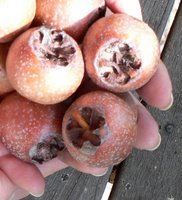 They will blet as they will, each medlar choosing to ripen to delicious rot in its own time.
They will blet as they will, each medlar choosing to ripen to delicious rot in its own time.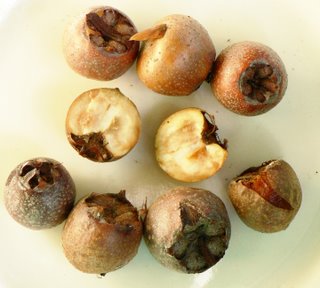 Unripe medlars (such as one cut open above) taste like snakefruit (another fruit that is outstandingly delicious as well as beautiful) but with added astringency. Unripe medlars were once so famously inedible that this characteristic succoured poets in the days when poets craved easily digestible metaphors.
Unripe medlars (such as one cut open above) taste like snakefruit (another fruit that is outstandingly delicious as well as beautiful) but with added astringency. Unripe medlars were once so famously inedible that this characteristic succoured poets in the days when poets craved easily digestible metaphors.Much has been written about the proper way to eat a bletted medlar. Peel a medlar, some say. Others: Eat it with a spoon.
This is a bletted medlar, peeled.

If you peel grapes, then do peel a medlar.
Otherwise, nip the medlar in its side as if you are a vampire and its tender, turgid, russet-skinned being is a plump neck. Now suck its guts out.
Or squeeze.
This is a bletted medlar, nipped and squeezed.
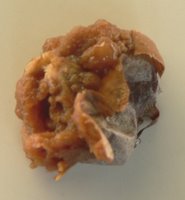
Now savour its complexity.
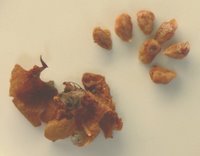
The skin has as much character as the skin of a good yam. And those are the pips. If you can spoon out the flesh of a medlar, you can probably do anything.
Medlars are innies until they overblet, at which point some become outies.
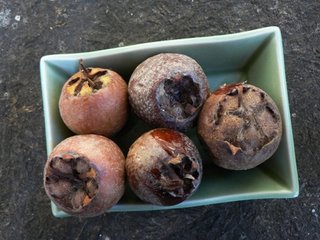
As can be seen above, there is often an anticipatory ooze that exudes from a medlar in just the right state for your pleasure. The ooze is the best candied jelly on this planet.
As for things to do with medlars other than eat them naked as they were born, they have been made into pastes and jellies, and folded into cream to make a fool.
Pastes and "cheeses" and jellies are delightful, and I love fools, but to my taste, these dressed-up versions slight the beauty of the naked medlar, and more importantly, imply that the medlar is like other modern fruits: bled of individuality. The essence of the medlar, and its charm, is that complex individuality.
Every medlar tastes as it will. It blets in its own time. Its texture and taste are unique and often contrarian. For these reasons, I prefer to eat medlars, guts and all, one by one.
They don't mind company, however.
Citrus becomes them, finely cut skins of mandarin (tangerine) especially, or whole kumquats. Uncandied, in all cases, as added sugars dull the sweetness in the medlars, and medlars are richly sweet. Walnuts are good company, as is wine, the kind of wine that furs your teeth, as any good wine does. If you make a paste of medlars, I don't recommend adding spice, but if you must, don't, please, use cinnamon, as it makes medlars taste like insipid apple. Cardamom brings out the flavours of date and fig and pear and spice that all live in each medlar's world of taste.
I once made chocolate-covered medlars. Absolutely disgusting. The medlars revolted in protest, going past the blet into full ferment. They served me right.
~~~~~~~~~~~~~~~~~~~~
Some other posts here on medlars:- Medlars, yum! Medlar comfits and more
- Medlars in spring, and their companions
- The first Onuspedia entry: 'Skwandro'
Medlars are such characters.
They often appear in my fiction, sometimes in cameos, but in these two stories, they have prominent roles.
- "Valley of the Sugars of Salt", now online for your delectation.
- "How Galligaskins Sloughed the Scourge", in Andromeda Spaceways Inflight Magazine #46
"Valley of the Sugars of Salt" has now also been published as an 'ebook single" by infinity plus, available from Amazon UK, Amazon US, and Smashwords. And if you like ebooks, you might prefer to have this story as part of the infinity plus bumper e-dition of Monterra's Deliciosa & Other Tales &)
And let us not forget those mistreated and spurned vegetables
May I recommend, oh friends of unusual discretion, my freshly published "Cardoons!"
"It didn't look cannable. It didn't look boilable. It looked like it could fight monsters, and win."Yes, this new long story is in a journal of horror, but please don't be put off by that any more than you are from what more than some people think of as the "swollen dead body" aspect of a perfectly bletted medlar. When the world recognises the yen we have for neglected-fruit-and-vegie fiction, we'll get our own genre. In the meantime, we've got to camp rough. Not that there aren't gollops of horror in Cardoons! — but one person's horror is another's irresistible temptation.

Great post, Anna. Once again, you eloquently show your love for medlars. And the pictures are great as well.
ReplyDeleteLove the post!!
ReplyDeleteNow I want to try one.
ReplyDeleteI hope you can forgive me for subjoining a link to a weblog entry of my own on the subject of medlars. Since writing it, I hazily recollected that I may indeed have sampled nespole during a visit to Venice.
ReplyDeleteDelighted, Erik, inspired, Alice, and misteraitch, to have such kind readers who enjoy what I'm mad about.
ReplyDeleteAnd misteraitch, that is an excellent weblog entry of yours. I read it quite a while ago and enjoyed it so much that it made me delve through your whole excellent blog, so Giornale Nuovo's been listed for some time in my linkslist titled "Cheese, Bread, & Medlars" on my other website. You've reminded me, so I think I'll add GN to the links list of Medlar Comfits, too.
Very pleased to have found this site, having just harvested medlars for the first time, from the garden of a house we moved into this summer. Love your turns of phrase, Anna, and your emphasis on the quirky personality of this fruit. I had some on toast with Blue Castello cheese the other day. It was a fiddle getting the guts out, no mistake - I had to fish out lots of pips - but their mild sweetness complemented the salty cheese nicely.
ReplyDeleteDear Tim,
ReplyDeleteReading your comment almost gave me indigestion. I immediately flew to your irresistible Rethinking Childhood, and sat here hitting my knees, crying Yesssssss! Your most recent post about making fires makes me think you might enjoy THE HEAT AND BRIGHTNESS
OF THE SUN (including an experiment with the burning glass, that most boys have often tried) by Sir Robert S. Ball. I posted it a few years ago, in a somewhat lame attempt to do what you are doing splendidly, now — encouraging society to let children move, explore, interact with nature (such a splendid report, your Sowing the Seeds - Reconnecting London's Children with Nature instead of seeing it as a source of germs and something to avoid, or conquer. I'll echo the comment from Canada, but change the country. You could certainly do good here in Australia. Children are natural naturalists, given the opportunities.
As to fear, you are sowing sense. I hope your fields grow rampant.
Btw, fear directed at children, for their own good, are the reasons for being, for my upcoming story "Cardoons!"
And your description of medlar eating makes my mouth water. As to the trickiness of eating them, yes, it is if you fish out the pips. Perhaps they should be eaten kind of like tequila is drunk. Eat a bite of something, suck a medlar. Eat, suck, savour...
Thanks again for taking the trouble to comment here with a delicious report (Blue Castello is such a nice match) and for your kind words. I've stopped this blog several times because of thoughts that no one gets anything from this patch of unkempt weeds.